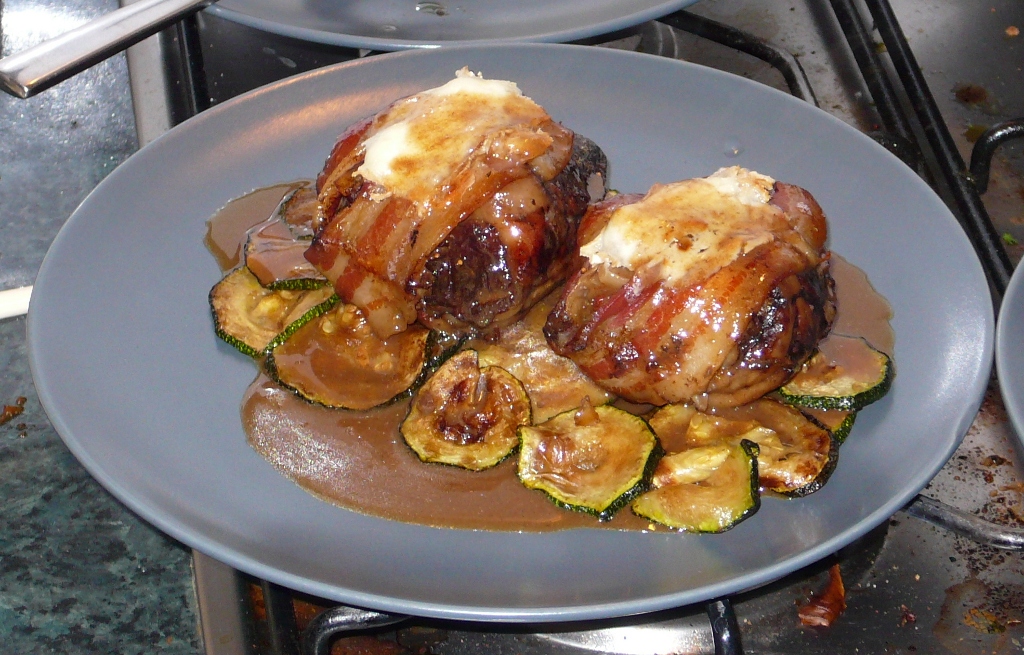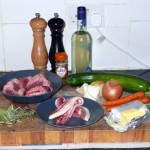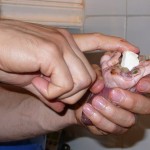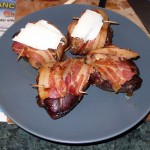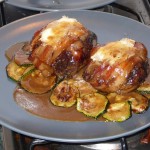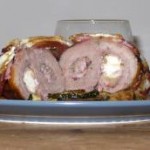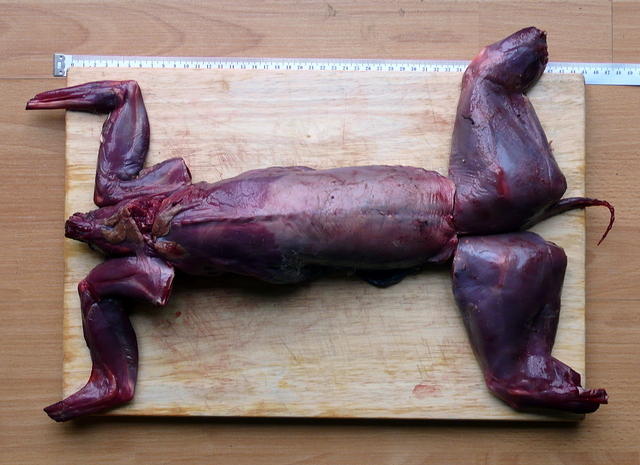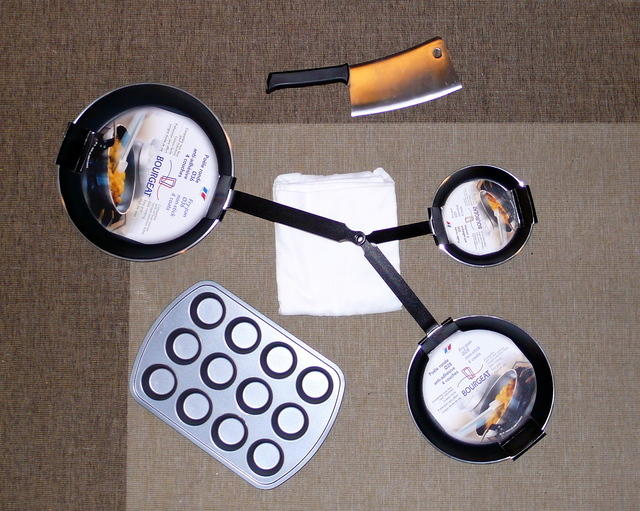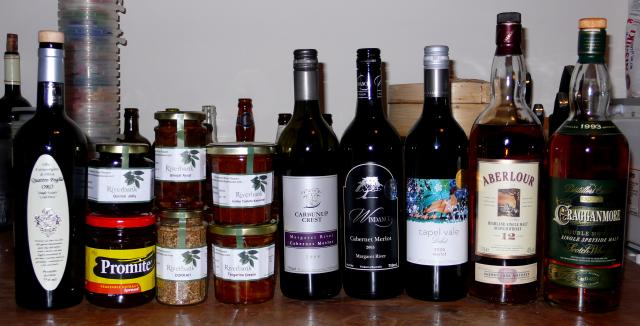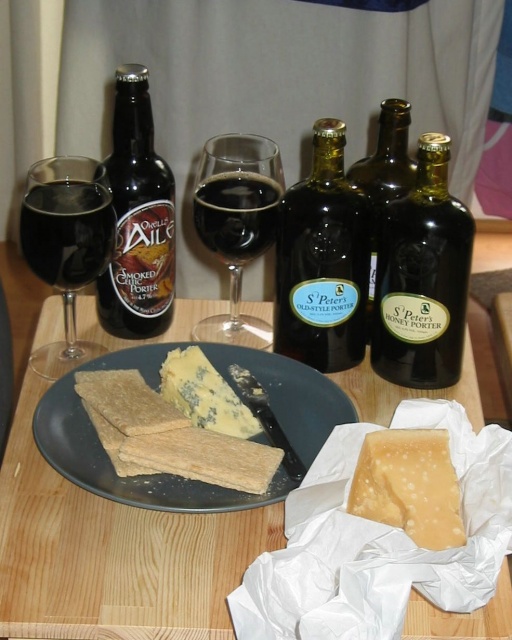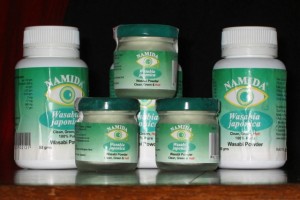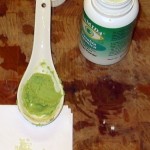Note: This entry has been restored from old archives.
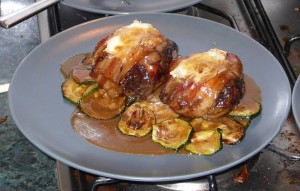
Have a heart! Really, I mean it. They taste great.
Our local butcher, Allinghams, gets fresh stuff in from Smithfield on Tuesdays. So I pre-ordered 4 lamb hearts last week and picked them up yesterday. The first great thing about lamb hearts is that they’re damn cheap, in this case less than 3 quid for the lot – good value considering it turned out to be more than a dinner for the two of us. The second great thing is that they’re simply delicious, with a rich flavour somewhere between lamb meat and liver.
I was at a little bit of a loss as to how to deal with them though, unfortunately none of my books cover what I wanted to do. I decided to plough on with my plan of stuffing them anyway, and went with braising them since this is a somewhat safe approach (much more forgiving than roasting.)
A passing reference in Hugh’s meat book suggests using a wet stuffing, so I avoided anything like breadcrumbs and shot for plenty of fat in the form of butter, bacon, and cheese. Ah, the cheese! We picked this up at the Hitchin Tuesday farmers’ market from Wobbly Bottom Farm. They have goats and make a range of excellent cheeses from goat milk, the Mature Goat is particularly delicious (it’s like a slightly goaty parmesan), as is the Blue Goat, but in this recipe it’s the excellent Goat Camembert I’ve used (which is really much harder than a Camembert!) The only other difference here is that I decided to add something for sweetness, as this tends to work very well with offal. Originally I considered sultanas but I keep dried figs in the same box. For some reason the figs just felt right, the rest is history, or, more accurately, dinner.
So, the ingredient manifest, some things here are listed twice where they’ve been used in different ways.
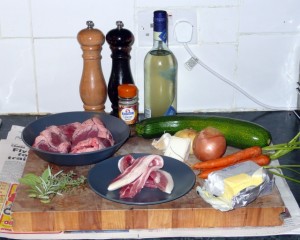
The hearts:
- 4 — lamb hearts
- 4 — rashers of streaky bacon
- 8 — toothpicks (they’re pretty important)
- 20g — unsalted butter
- 4 — thin slices of Goat Camembert (alternative: firm feta)
The stuffing:
- 25g — unsalted butter
- ½ tsp — caraway seeds
- 2 small (230g) — onions
- 2 (~60g) — rashers of streaky bacon
- 1 tsp — fresh ground black pepper
- 1 — garlic clove
- 4 (~50g) — dried figs
- sprig (~8 leaves) — sage
- sprig (2″) — rosemary
- 40g — Goat Camembert (alternative: firm feta)
The juice:
- 100g — carrot
- 1 — garlic clove
- 2 — generous sprigs of thyme
- 250ml — dry white wine
- 400ml — chicken stock
The base:
- 1 — large courgette (zucchini – fresh from the garden!)
- a little — oil for frying
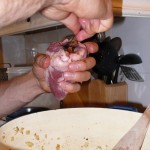
First clean your hearts, for this I recommend a short and very sharp knife, best to start by sharpening it actually. Trim any arteries out of the top of the heart and slit, just deep enough to graze the muscle, along any veins on the outside of the heart. A book I have suggests removing such veins, but this seemed to be far too finicky to me. Next give your hearts a good rinse, especially flushing any clots of blood out of the cavities and flushing blood out of the veins you’ve slit. Thoroughly dry the hearts with some paper towel, giving them a good squeeze to remove excess water from inside. Now put them aside while you prepare the stuffing.
Now is probably a good time to get the oven on, set it to 125°C.
Dice the onion into pieces about 5mm to a side and get them sizzling in a heavy casserole with 25g of butter and the caraway seeds. Slice the 2 rashers of streaky bacon into thin strips and add to the onion. Let this lot sizzle until it lightly browns. Very finely chop the garlic, sage, and rosemary and add to the pot with the pepper. Chop the figs into pieces about 5mm to a side and add as well. Now fry for about 5 more minutes until the fig pieces are softened. Turn off the heat and let it cool for a couple of minutes, until you can handle it.
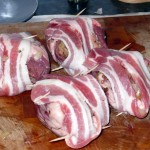
Divide the stuffing mix up into 4 even piles and proceed to stuff the cavities of each heart. A teaspoon is a useful tool for this. Once the hearts are stuffed there should be about a tablespoon of assorted stuffing left over in the casserole, this will help flavour the sauce. Slice your cheese into 4 “spears,” chunky enough to push into the hearts without crumbling (it’s best to have the cheese in the fridge up to here as this will keep it a bit harder.) Thoroughly embed a spear of cheese into each heart.
Now lie a piece of streaky bacon over the cavity opening, doubling it back on itself to cover as much of the opening as possible. Use two toothpicks to hold the bacon in place (see photo.)
Add another 20g of butter to the casserole and over a medium flame lightly brown the hearts on as many sides as they’ll sit on. With this done ensure all the hearts are sitting with the bacon (cavity holes) facing upward and pour the white wine and chicken stock in around the hearts. Peel and roughly chop the carrots, toss them in, skin the garlic and thump it to death under the side of a knife, toss this in too.
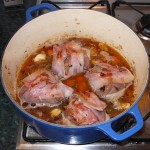
Finally submerge the thyme in the liquid, get it simmering over the stove, then pop the lid on the casserole and shove it in the oven!
If you’re us the next thing to do is pop down to the local pub for 2 hours and have a couple of beers. With 2 hours up take the casserole out of the oven and turn each heart cavity-side-down. They go back in the oven for another hour now.
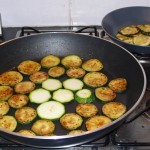
About 20 minutes before the hearts are due to come out of the oven slice the courgette into thin (~3mm) rounds, a mandolin is invaluable for this sort of thing. Drizzle a little oil in a large fry-pan and brown the rounds of courgette on each side, this will need to be done in batches (unless you have a truly enormous frying pan!)
casserole onto a plate, carefully remove the toothpicks, and top each heart with a slice of cheese. These can now go back into the oven, but turn it off and leave the door slightly ajar (we’re just keeping them warm at this stage, not trying to cook them further.) It is also a good idea to pop a couple of serving plates in the oven at this point.
Pass the liquid and vegetables from the casserole through a food mill or push it through a course sieve. Place this back onto the stove and reduce over high heat until it reaches the consistency of runny cream. Be careful here, tasting the sauce regularly. The main issue to worry about is salt. There may be a lot of salt in the sauce from the bacon and stock – good stock won’t have added salt, but most bought stocks do have some and stock cubes are very salty! If the sauce verges toward the salty side before it is thick enough you could try thickening it up a little with some cornflour solution. If it isn’t very salty then you can, as they say, “season to taste.” Finish the sauce by passing it through a fine sieve.
Pop the hearts under a hot overhead grill to get the cheese just-sizzling. Create a bed of courgette slices on the two warmed plates and put two hearts on each plate. Drizzle with some sauce and serve with a glass of the wine used in the cooking and a jug containing any excess sauce. This turned out to be a rather rich meal so the dry white wine worked well as a balance.

This is a large meal, two hearts filled me well and one was enough for Kat. An alternative would be to serve one heart per person, in which case I’d double the amount of courgette used and serve with something additional on the side, a small green salad maybe.
Another alternative presentation for the hearts is to slice them, since the cross-section is rather attractive. Our leftover heart will be prepared in this way and served cold as the centrepiece of a lunchtime salad.
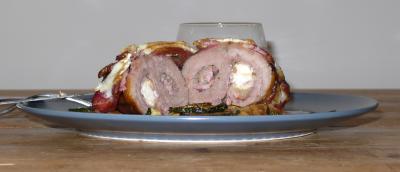
As usual the recipe is also documented in photos:
